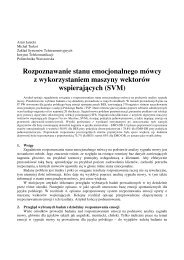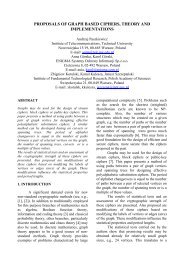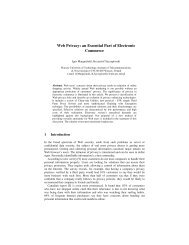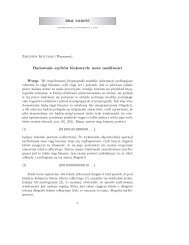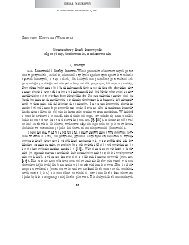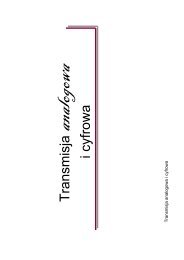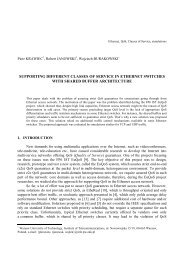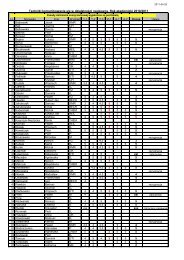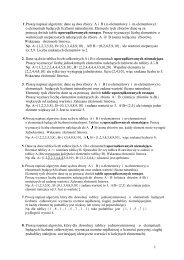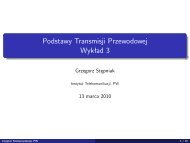Steganography and steganalysis in cryminology [tryb ... - cygnus
Steganography and steganalysis in cryminology [tryb ... - cygnus
Steganography and steganalysis in cryminology [tryb ... - cygnus
Create successful ePaper yourself
Turn your PDF publications into a flip-book with our unique Google optimized e-Paper software.
<strong>Steganography</strong> <strong>and</strong><br />
<strong>steganalysis</strong> <strong>in</strong> crim<strong>in</strong>ology<br />
Mp<br />
magdap7@gazeta.pl
Introduction<br />
Introduction to steganography<br />
Branches of crim<strong>in</strong>ology<br />
Steganographic programs<br />
Computer Forensics Tools<br />
Steganalytic tools<br />
Conclusions
Branches of crim<strong>in</strong>ology<br />
F<strong>in</strong>gerpr<strong>in</strong>t identification<br />
H<strong>and</strong>-writ<strong>in</strong>g recognition<br />
Speech recognition<br />
Audio authentication<br />
Computer forensic methods<br />
Many other concern<strong>in</strong>g biology <strong>and</strong><br />
chemistry beyond this presentation
Issues <strong>in</strong> computer forensic<br />
Forbidden data, photos, films<br />
Malicious scripts<br />
Illegal access <strong>and</strong> modification of data<br />
Violation of Intellectual property
What steganography is<br />
The art <strong>and</strong> science of writ<strong>in</strong>g hidden messages<br />
<strong>in</strong> such a way that no one, apart from the<br />
sender <strong>and</strong> <strong>in</strong>tended recipient, suspects the<br />
existence of the message<br />
The word steganography is of Greek orig<strong>in</strong> <strong>and</strong><br />
means "concealed writ<strong>in</strong>g" from the Greek<br />
words steganos (στεγανός) mean<strong>in</strong>g "covered or<br />
protected", <strong>and</strong> graphei (γραφή) mean<strong>in</strong>g<br />
"writ<strong>in</strong>g".
Data embedd<strong>in</strong>g security scheme<br />
Some data to hide<br />
Carrier data<br />
Steganographic key<br />
Steganographic<br />
function<br />
Reverse<br />
steganographic<br />
function<br />
Steganographic<br />
object<br />
Recovered data
Doma<strong>in</strong>s of data hid<strong>in</strong>g<br />
Physical {wax tablets, secret <strong>in</strong>k}<br />
Digital {text, image, audio, video}<br />
Network {packets}<br />
Pr<strong>in</strong>ted {letter size, spac<strong>in</strong>g}
Doma<strong>in</strong>s of data embedd<strong>in</strong>g<br />
Unused areas of carrier objects<br />
Headers or tails of carrier objects<br />
Used but not significant areas<br />
– Time or spatial doma<strong>in</strong><br />
– Frequency doma<strong>in</strong><br />
Noisy parts of carrier objects<br />
Outside the audibility thresholds<br />
LSB method<br />
Indexed palette of colors<br />
Spread data evenly with a key<br />
Choose the best area for data hid<strong>in</strong>g
What steganography has to do <strong>in</strong><br />
the art of crim<strong>in</strong>ology<br />
Data hid<strong>in</strong>g <strong>and</strong> hidden data detection<br />
Watermark<strong>in</strong>g<br />
– to protect property<br />
– to discover <strong>in</strong>consistencies <strong>in</strong> audio files<br />
Pattern recognition<br />
Similar techniques of analysis
<strong>Steganography</strong> <strong>and</strong> watermark<strong>in</strong>g<br />
Inaudibility, as little as possible loss of audio<br />
quality<br />
Robustness, the algorithm should be robust<br />
aga<strong>in</strong>st various attacks for malicious users<br />
Statistical <strong>in</strong>visibility, the algorithm should prevent<br />
unauthorized watermark detection/removal or<br />
alteration<br />
Similar compression characteristics with the<br />
orig<strong>in</strong>al signal<br />
No orig<strong>in</strong>al data is needed to recognize the<br />
watermark
Approaches to f<strong>in</strong>gerpr<strong>in</strong>t<br />
recognition<br />
Pattern-based (Image-based) algorithms<br />
– compare the basic f<strong>in</strong>gerpr<strong>in</strong>t patterns (arch, whorl, <strong>and</strong><br />
loop) between a previously stored template <strong>and</strong> a<br />
c<strong>and</strong>idate f<strong>in</strong>gerpr<strong>in</strong>t<br />
M<strong>in</strong>utia-based algorithms<br />
– compare several m<strong>in</strong>utia po<strong>in</strong>ts (ridge end<strong>in</strong>g,<br />
bifurcation, <strong>and</strong> short ridge) extracted from the orig<strong>in</strong>al<br />
image stored <strong>in</strong> a template with those extracted from a<br />
c<strong>and</strong>idate f<strong>in</strong>gerpr<strong>in</strong>t
Selection of an optimization<br />
technique<br />
<br />
<br />
<br />
<br />
<br />
Exhaustive techniques (r<strong>and</strong>om walk, depth first, breadth first,<br />
enumerative)<br />
Calculus-based techniques (gradient methods, solv<strong>in</strong>g systems<br />
of equations)<br />
Partial knowledge techniques (hill climb<strong>in</strong>g, beam search, best<br />
first, branch <strong>and</strong> bound, dynamic programm<strong>in</strong>g)<br />
Knowledge-based techniques (production rule systems, heuristic<br />
methods<br />
Hierarchical techniques: Generally, a coarse resolution employed<br />
to f<strong>in</strong>d a narrow range of the solution, then us<strong>in</strong>g a f<strong>in</strong>e<br />
resolution <strong>in</strong> the narrow range search the optimal solution
Model for f<strong>in</strong>gerpr<strong>in</strong>t<br />
comparison<br />
The optimized transformation<br />
The fitness function<br />
Genetic algorithm used to estimate the<br />
optimized transformation<br />
The phenomena – only small fraction of<br />
possibilities is calculated to prove the<br />
hypothesis
Genetic approach to pattern<br />
recognition<br />
a vector values for optimization is represented as a<br />
chromosome (genotype)<br />
each chromosome consists of a set of genes<br />
(values bits or bytes), they are grouped <strong>in</strong>to<br />
segments<br />
start<strong>in</strong>g population is a subset of all possible<br />
genotypes - r<strong>and</strong>om choice of <strong>in</strong>dividuals<br />
<strong>in</strong> each iteration a new population is created by<br />
mak<strong>in</strong>g small changes <strong>in</strong> the parent population
Example<br />
Fitness function to be optimized
Generat<strong>in</strong>g new population<br />
<br />
<br />
<br />
<br />
<br />
cross<strong>in</strong>g over segments from<br />
parents<br />
r<strong>and</strong>om permutation of<br />
segment<br />
exclud<strong>in</strong>g chromosomes, which<br />
are<br />
– already created (repeat<strong>in</strong>g)<br />
– have the fitness value under<br />
the desired threshold (outside<br />
the desired range)<br />
sort<strong>in</strong>g the population <strong>in</strong><br />
decreas<strong>in</strong>g order by the fitness<br />
values<br />
selection of the next<br />
generation of descendants
Approaches to watermark creation<br />
Any bit-sequence may be seen under two different<br />
views:<br />
– 1) Syntactically, i.e. how it looks like as a sequence of 0’s <strong>and</strong><br />
1’s. Then the sequence’s characteristics <strong>and</strong> properties are<br />
determ<strong>in</strong>ed simply by the pattern of 0’s <strong>and</strong> 1’s.<br />
– 2) Semantically, i.e. whether <strong>in</strong> fact, it represents by design<br />
another entity/object converted <strong>in</strong>to the bit-sequence under the<br />
action of a suitable encod<strong>in</strong>g. This time the sequence, <strong>in</strong><br />
addition to its syntactic characteristics, may also be seen as<br />
possess<strong>in</strong>g characteristics <strong>and</strong> properties <strong>in</strong>herited from the<br />
entity/object from which it resulted.
Embedd<strong>in</strong>g data <strong>in</strong> mp3 files<br />
Audio file is divided <strong>in</strong>to frames<br />
In each frame the Scalefactors are the<br />
values of sound amplitude for a given<br />
frequency<br />
Differences between adjacent scalefacors<br />
are calculated<br />
The watermark pattern is embedded <strong>in</strong><br />
these areas where the changes would cause<br />
the least loss of quality
<strong>Steganography</strong> tools<br />
Contrab<strong>and</strong><br />
F5.jar<br />
MP3Stego<br />
OpenStego<br />
Invisible Secrets<br />
S-Tools<br />
VSL<br />
BMP<br />
JPEG<br />
MP3<br />
BMP,PNG<br />
BMP,JPEG<br />
BMP,GIF,WAV<br />
BMP,PNG,JPG,TIFF
The types of attack on<br />
steganographic algorithms<br />
Known program <strong>and</strong> unknown algorithm<br />
Chosen message <strong>and</strong> series of chosen<br />
carrier files<br />
Unknown steganographic program <strong>and</strong> a<br />
s<strong>in</strong>gle suspected file
Simple methods to detect<br />
File signature<br />
steganography<br />
Steganographic f<strong>in</strong>gerpr<strong>in</strong>t<br />
Statistical anomaly<br />
Brute force attack (time <strong>and</strong> space<br />
consum<strong>in</strong>g)
HEX Viewer<br />
Jhead.exe<br />
Hexadecimal Preview
File Signature Analysis<br />
25h 50h 44h 46h<br />
FFh D8h FFh<br />
D0h CFh 11h E0h A1h B1h 1Ah E1h<br />
PDF<br />
JPEG<br />
MS Office<br />
By compar<strong>in</strong>g it with file extensions we discover<br />
hidden files (for <strong>in</strong>stance naked.doc)
Tools for Steganalysis<br />
Stegdetect is an automated tool for<br />
detect<strong>in</strong>g steganographic content <strong>in</strong> JPEG<br />
images<br />
Stegbreak is used to launch dictionary<br />
attacks aga<strong>in</strong>st JSteg-Shell, JPHide <strong>and</strong><br />
OutGuess 0.13b.
Tools for Steganalysis<br />
<br />
<br />
<br />
StegDetect<br />
– Uses L<strong>in</strong>ear discrim<strong>in</strong>ant analysis<br />
computes a divid<strong>in</strong>g hyperplane that<br />
separates the no-stego images from<br />
the stego images.<br />
Virtual Steganographic Laboratory<br />
– Set of steganographic modules<br />
– Set of tools for statistical analysis<br />
– Possibility to write own add-<strong>in</strong>s<br />
Matlab Tool<br />
– Visual preview of multi-dimensional<br />
data<br />
– Built-<strong>in</strong> Statistical tools<br />
– Operations on vectors <strong>and</strong> matrixes of<br />
values
Hash analysis<br />
specify a list of MD5s<br />
f<strong>in</strong>d<strong>in</strong>g several known bad files,<br />
– files from a rootkit<br />
– illegal images<br />
the MD5s that compose file (KNOWN.BAD) of already<br />
known files such as<br />
– f53ce230616c1f6aafedf546a7cc0f0f Trojan ps<br />
– bbf3aeb654477c4733bddf9a6360d2c5 Illegal Image<br />
run md5deep aga<strong>in</strong>st all of the files <strong>in</strong> the directory<br />
It compares the file’s hashes with the contents of the list<br />
of known hashes. If a match occurs, it lists it on<br />
st<strong>and</strong>ard out
F<strong>in</strong>d<strong>in</strong>g Files by Type <strong>and</strong> Keyword<br />
Searches<br />
# f<strong>in</strong>d / -type f \( -name ‘*.gif’ –or –name ‘*.jpg’<br />
–or –name ‘*.bmp’ –or –name ‘*.png’ \)<br />
# grep –i –r –f keywords /image/* ><br />
/evidence/grep.results<br />
– i - case <strong>in</strong>sensitive search, thus ‘coca<strong>in</strong>e,’ ‘COCAINE.’<br />
<strong>and</strong> ‘CoCa<strong>in</strong>E’<br />
– r - a recursive search, i.e., traverse all of the<br />
subdirectories beneath the current directory.<br />
– f - the next parameter is the file conta<strong>in</strong><strong>in</strong>g our<br />
keywords.
Hierarchic file search<br />
To f<strong>in</strong>d all graphical files regardless of<br />
extension – 3 steps<br />
– 1: f<strong>in</strong>d comm<strong>and</strong> to f<strong>in</strong>d all regular files on<br />
the hard drive<br />
– Pipe the results to the next step<br />
– 2: file comm<strong>and</strong>, which returns the type of file<br />
us<strong>in</strong>g header <strong>in</strong>formation.<br />
– Pipe the results to the next step<br />
– 3: grep comm<strong>and</strong> to search for graphicalrelated<br />
keywords.
Timestamp <strong>in</strong> electric hum<br />
European electricity network<br />
local fluctuations <strong>in</strong> the current frequency (around expected value of<br />
50Hz)<br />
the frequency is the function of time <strong>and</strong> equal on a given area<br />
a correlation is observed <strong>in</strong> the fluctuations <strong>in</strong> all union area (Union<br />
for the Coord<strong>in</strong>ation of the Transmission of Electricity)<br />
one can estimate the time of audio record<strong>in</strong>g, because an additional<br />
signal is added due to the frequency fluctuations<br />
PSE-operators store values of frequency <strong>in</strong> data bases s<strong>in</strong>ce 1997<br />
Thus an <strong>in</strong>vestigator can detect if a given evidence audio has been<br />
manipulated, reassembled or partially replaced
Example spectrum
Forensic Tools<br />
<br />
<br />
<br />
<br />
Pasco (www.foundstone.com) - parses the contents of <strong>in</strong>dex.dat files, <strong>and</strong><br />
outputs the results <strong>in</strong>to a tab delimited file<br />
rifuiti (www.foundstone.com) - <strong>in</strong>terprets the b<strong>in</strong>ary contents of the INFO2<br />
file.<br />
EnCase (Forensic or Enterprise Editions www.guidancesoftware.com)<br />
Accessdata’s Forensic Toolkit (part of the Ultimate Toolkit:<br />
www.accessdata.com).<br />
– imag<strong>in</strong>g;<br />
– read<strong>in</strong>g multiple file systems;<br />
– read<strong>in</strong>g<br />
– multiple image formats;<br />
– file view<strong>in</strong>g; advanced str<strong>in</strong>g searches;<br />
– graphical/gallery views;<br />
– email analysis;<br />
– compressed file analysis;<br />
– known file filters/hash analysis;<br />
– bad file extension determ<strong>in</strong>ation
Commercial Forensic Tools<br />
• ARS Data’s SMART (runs under L<strong>in</strong>ux):<br />
http://www.asrdata.com/tools/<br />
• ILook Investigator (law enforcement only):<br />
http://www.ilook-forensics.org/<br />
• Maresware Forensic Tools:<br />
http://www.dmares.com/maresware<br />
• New Technologies Forensic Suite:<br />
http://www.forensics-<strong>in</strong>tl.com/tools.html<br />
• Paraben Forensic Toolks: http://www.parabenforensics.com/
Conclusions<br />
People DO use steganography, while<br />
governments ban cryptography<br />
<strong>Steganography</strong> CAN be useful due to<br />
watermark<strong>in</strong>g<br />
<strong>Steganography</strong> is difficult to be detected –<br />
it requires brute force attacks <strong>and</strong> huge<br />
size of computer resources
Do you have questions?<br />
search of an automated tool which will<br />
automatically RUN, provide with<br />
PASSWORDS, <strong>and</strong> retrieve RESULTS form<br />
various steganographic programs<br />
needed help from computers on the<br />
Internet to run simultaneously (sth similar<br />
to the BOINC project
L<strong>in</strong>ks<br />
http://en.wikipedia.org/wiki/<strong>Steganography</strong><br />
http://www.outguess.org/detection.php<br />
http://www.zvetcobiometrics.com/Support/security_tech<br />
nology/algorithms.php
Bibliography - 1<br />
„Information Hid<strong>in</strong>g Us<strong>in</strong>g Audio <strong>Steganography</strong> - A Survey”, Jayaram P,<br />
Ranganatha H R, Anupama H S, Department of Computer Science <strong>and</strong><br />
Eng<strong>in</strong>eer<strong>in</strong>g, R V College of Eng<strong>in</strong>eer<strong>in</strong>g, Bangalore, INDIA, The<br />
International Journal of Multimedia & Its Applications (IJMA) Vol.3, No.3,<br />
August 2011<br />
„A Watermark<strong>in</strong>g Scheme for MP3 Audio Files” - Dimitrios Koukopoulos,<br />
Yiannis Stamatiou,International Journal of Information <strong>and</strong> Communication<br />
Eng<strong>in</strong>eer<strong>in</strong>g, 2006<br />
„Hide <strong>and</strong> Seek: An Introduction to Stegangography” - Niels Provos <strong>and</strong><br />
Peter Honeyman, IEEE Security & Privacy Magaz<strong>in</strong>e, May/June 2003.<br />
„F<strong>in</strong>gerpr<strong>in</strong>t match<strong>in</strong>g by genetic algorithms” - Xuejun Tan, Bir Bhanu,<br />
Center for Research <strong>in</strong> Intelligent System, University of California, Riverside,<br />
CA 92521, USA<br />
„Analiza wahań częstotliwości prądu sieciowego w badaniach autentyczności<br />
nagrań cyfrowych” - Iwona Biernacka, Rafał Korycki, Jacek Rzeszotarski,<br />
Przegląd Bezpieczeństwa Wewnętrznego, ABW<br />
„Analiza działania wybranych aplikacji steganograficznych” - Marta<br />
Walenczykowska, Przegląd Bezpieczeństwa Wewnętrznego, ABW
Software downloads<br />
<br />
<br />
<br />
<br />
<br />
<br />
<br />
<br />
<br />
http://www.jjtc.com/<br />
http://www.outguess.org/<br />
http://sourceforge.net/projects/vsl/<br />
http://www.<strong>in</strong>visiblesecrets.com/<br />
https://www.mathworks.com/products/matlab/trial.html<br />
http://md5deep.sourceforge.net/<br />
https:// www.foundstone.com<br />
https:// www.guidancesoftware.com<br />
https:// www.accessdata.com




